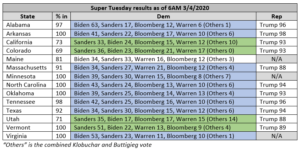Updated 3/4 PM and 3/5 AM to reflect Bloomberg and Warren withdrawals
Super Tuesday has concluded, and former Vice President Joe Biden has staged an incredible comeback. He certainly didn’t look like a viable candidate until recently: he started off with a fourth place finish in Iowa and 15% of the vote. In New Hampshire, he finished fifth with 8% of the vote. He saw partial redemption in Nevada with a second place showing and 18% of the vote, then he surged in South Carolina to a strong first place finish with 48% of the vote.
Combine that unambiguous victory with the rapid withdrawal of (and endorsements from) both Pete Buttigieg and Amy Klobuchar in the aftermath of the South Carolina, and Joe Biden certainly ran the tables on Super Tuesday. Not only did he win nine out of 14 contests (Sanders won four, and Maine is too close to call), but these wins were across the Eastern and Central Time Zones in non black majority electorates. Of Bernie Sanders’ victories, one was in the Eastern Time Zone, two were in the Mountain Time Zone, and he appears to have clinched California in the Pacific Time Zone. Given the size of the Biden victory, what are the other takeaways from these contests (results posted below) ?
Strong Democratic turnout: In 12/14 contests, Democratic turnout last night exceeded 2016 Democratic turnout, and in 7 of those 12 contests, Democratic turnout exceeded 2008 turnout (those states were Colorado, Maine, Massachusetts, Minnesota, Utah, Vermont, and Virginia). To be technically correct, there are two caveats: (1) Colorado, Maine, Minnesota, and Utah switched from a caucus to a primary this year, and the less cumbersome primaries generate higher voter turnout, (2) while California and Oklahoma did not even attain 2016 level turnout, California is a “work in progress” regarding turnout. Thanks to a large percentage of mail in ballots (59% of the vote in the 2016 primary was cast by mail) that are cast, vote counting takes a month to complete. So even though as of the writing of this article, 2.7 million Democratic votes were cast for President (compared to 5.1 million in 2008 and 5.2 million in 2016), JMC estimates that easily another 3-4 million votes have yet to be counted, which would then result in record turnout in that state.
And then there were two (plus Tulsi): Bernie Sanders’ winning four states (California, Colorado, Utah, and Vermont) keeps him in the race, although he clearly has lost any perception of dominance – outside of the 51% he received in his home state of Vermont, he dd not exceed 36% of the vote in any state. And those victories are considering he’s getting marginal competition in the “liberal swim lane” from Elizabeth Warren, who not only lost her home state of Massachusetts, but outside of Massachusetts, could not attain more than 17% of the vote in any state. She (as predicted yesterday) has now begun her death spiral into irrelevance, and two days after Super Tuesday, she recognized the obvious and dropped out of the race. Similarly, Michael Bloomberg’s honeymoon with Democrats rapidly ended after faltering performances in two successive debates (his skipping the first four contests certainly didn’t help). He did not receive more than 21% of the vote in any contest, and there are now questions as to whether he will even remain in the race, considering the massive amount of funds he spent, only to end up far short of viability, let alone victory. These considerations were obviously on his mind when he dropped out of the race the morning after the primaries and endorsed Biden, thus leaving him with a clear “moderate swim lane.”
The “AmyPete factor”: Given that Amy Klobuchar and Pete Buttigieg quickly ended their candidacies after South Carolina, and too soon to take their names off the ballots in many of the Super Tuesday contests, did their diversion of “moderate” votes hurt Joe Biden ? The answer is clearly “no.” For one thing, Biden did win 9 out of 14 contests. And in the four contests Sanders won, only in California did the combined vote of Buttigieg, Klobuchar, and Biden surpass the Sanders vote, and even then, only barely. The more salient point here is that Biden’s late surge was strong enough to where their withdrawals didn’t in the end materially matter or hurt him.
Next contests: There are 11 more contests this month (Louisiana’s is the 12th, on April 4). Six of those contests are next week: Idaho, Michigan, Mississippi, Missouri, North Dakota, and Washington State. Given how the primary contests have gone thus far, Mississippi, Missouri, and North Dakota are likely to go to Biden. Idaho and Washington State are likely to support Sanders. Michigan is a wildcard: its blacks and union voters are likely Biden voters, but Sanders pulled an upset in the 2016 primary.
In conclusion, this has rapidly come down to a Biden versus Sanders race, and Joe Biden is (for now, anyway) in a commanding position in the Democratic race.

